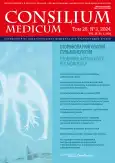The multifaceted erdostein: facts on the desk. A review
- Authors: Babak S.L.1, Gorbunova M.V.1, Karnaushkina M.A.2
-
Affiliations:
- Russian University of Medicine
- Patrice Lumumba Peoples' Friendship University of Russia (RUDN University)
- Issue: Vol 26, No 3 (2024): Otorhinolaryngology and pulmonology
- Pages: 182-186
- Section: Articles
- URL: https://journals.rcsi.science/2075-1753/article/view/256730
- DOI: https://doi.org/10.26442/20751753.2024.3.202740
- ID: 256730
Cite item
Full Text
Abstract
Erdostein is a mucoactive agent belonging to the group of thiol drugs with antioxidant, anti-inflammatory and antibacterial activity against a number of major respiratory pathogens. After transformation in the liver, erdostein is metabolized to a compound with an open ring M1 (MET-1) having unique properties. In the RESTORE study (2022), it was confirmed that erdostein significantly reduces the risks of severe exacerbations in patients with chronic obstructive pulmonary disease (COPD), reduces their duration, and reduces the number of hospitalizations with acute respiratory failure (ARF). The unique preventive properties of erdostein do not depend on the administration of inhaled (ICS) or systemic (SCS) corticosteroids to COPD patients, as well as on the level of eosinophilia in the blood. The results obtained contrast with the available therapy strategy, where thiol mucolytics are indicated in patients who do not use ICS-therapy and/or SCS-therapy. Moreover, this confirms the assumption about the use of erdostein in COPD patients as a drug for the phased withdrawal of ICS-therapy.
Full Text
##article.viewOnOriginalSite##About the authors
Sergey L. Babak
Russian University of Medicine
Author for correspondence.
Email: sergbabak@mail.ru
ORCID iD: 0000-0002-6571-1220
D. Sci. (Med.), Assoc. Prof.
Russian Federation, MoscowMarina V. Gorbunova
Russian University of Medicine
Email: mgorb@mail.ru
D. Sci. (Med.)
Russian Federation, MoscowMariia A. Karnaushkina
Patrice Lumumba Peoples' Friendship University of Russia (RUDN University)
Email: kar3745@yandex.ru
ORCID iD: 0000-0002-8791-2920
D. Sci. (Med.)
Russian Federation, MoscowReferences
- Dechant KL, Noble S. Erdosteine. Drugs. 1996;52(6):875-81; discussion 882. doi: 10.2165/00003495-199652060-00009
- Cazzola M, Calzetta L, Page C, et al. Thiol-Based Drugs in Pulmonary Medicine: Much More than Mucolytics. Trends Pharmacol Sci. 2019;40(7):452-63. doi: 10.1016/j.tips.2019.04.015
- Miyake K, Kaise T, Hosoe H, et al. The effect of erdosteine and its active metabolite on reactive oxygen species production by inflammatory cells. Inflamm Res. 1999;48(4):205-9. doi: 10.1007/s000110050447
- Dal Negro RW. Erdosteine: antitussive and anti-inflammatory effects. Lung. 2008;186(Suppl. 1):S70-3. doi: 10.1007/s00408-007-9065-3
- Hosoe H, Kaise T, Ohmori K. Erdosteine enhances mucociliary clearance in rats with and without airway inflammation. J Pharmacol Toxicol Methods. 1998;40(3):165-71. doi: 10.1016/s1056-8719(98)00053-7
- Cohen NA. Sinonasal mucociliary clearance in health and disease. Ann Otol Rhinol Laryngol Suppl. 2006;196:20-6. doi: 10.1177/00034894061150s904
- Moretti M, Marchioni CF. An overview of erdosteine antioxidant activity in experimental research. Pharmacol Res. 2007;55(4):249-54. doi: 10.1016/j.phrs.2006.12.006
- Marabini L, Calò R, Braga PC. Protective effect of erdosteine metabolite I against hydrogen peroxide-induced oxidative DNA-damage in lung epithelial cells. Arzneimittelforschung. 2011;61(12):700-6. doi: 10.1055/s-0031-1300590
- Braga PC, Culici M, Dal Sasso M, et al. Free radical scavenging activity of erdosteine metabolite I investigated by electron paramagnetic resonance spectroscopy. Pharmacology. 2010;85(4):195-202. doi: 10.1159/000275063
- Demiralay R, Gürsan N, Ozbilim G, et al. Comparison of the effects of erdosteine and N-acetylcysteine on apoptosis regulation in endotoxin-induced acute lung injury. J Appl Toxicol. 2006;26(4):301-8. doi: 10.1002/jat.1133
- Lee IT, Yang CM. Role of NADPH oxidase/ROS in pro-inflammatory mediators-induced airway and pulmonary diseases. Biochem Pharmacol. 2012;84(5):581-90. doi: 10.1016/j.bcp.2012.05.005
- Park JS, Park MY, Cho YJ, et al. Anti-inflammatory Effect of Erdosteine in Lipopolysaccharide-Stimulated RAW 264.7 Cells. Inflammation. 2016;39(4):1573-81. doi: 10.1007/s10753-016-0393-4
- Jang YY, Song JH, Shin YK, et al. Depressant effects of ambroxol and erdosteine on cytokine synthesis, granule enzyme release, and free radical production in rat alveolar macrophages activated by lipopolysaccharide. Pharmacol Toxicol. 2003;92(4):173-9. doi: 10.1034/j.1600-0773.2003.920407.x
- Hayashi K, Hosoe H, Kaise T, Ohmori K. Protective effect of erdosteine against hypochlorous acid-induced acute lung injury and lipopolysaccharide-induced neutrophilic lung inflammation in mice. J Pharm Pharmacol. 2000;52(11):1411-6. doi: 10.1211/0022357001777414
- Demiralay R, Gürsan N, Erdem H. Regulation of sepsis-induced apoptosis of pulmonary cells by posttreatment of erdosteine and N-aceylcysteine. Toxicology. 2006;228(2-3):151-61. doi: 10.1016/j.tox.2006.08.027
- Braga PC, Dal Sasso M, Culici M, et al. Effect of metabolite I of erdosteine on the release of human neutrophil elastase. Pharmacology. 2006;77(3):150-4. doi: 10.1159/000094379
- Braga PC, Zuccotti T, Dal Sasso M. Bacterial adhesiveness: effects of the SH metabolite of erdosteine (mucoactive drug) plus clarithromycin versus clarithromycin alone. Chemotherapy. 2001;47(3):208-14. doi: 10.1159/000063223
- Dal SM, Bovio C, Culici M, Braga PC. The combination of the SH metabolite of erdosteine (a mucoactive drug) and ciprofloxacin increases the inhibition of bacterial adhesiveness achieved by ciprofloxacin alone. Drugs Exp Clin Res. 2002;28(2-3):75-82.
- Cazzola M, Floriani I, Page CP. The therapeutic efficacy of erdosteine in the treatment of chronic obstructive bronchitis: a meta-analysis of individual patient data. Pulm Pharmacol Ther. 2010;23(2):135-44. doi: 10.1016/j.pupt.2009.10.002
- Cazzola M, Calzetta L, Page C, et al. Impact of erdosteine on chronic bronchitis and COPD: A meta-analysis. Pulm Pharmacol Ther. 2018;48:185-94. doi: 10.1016/j.pupt.2017.11.009
- Calverley PMA, Papi A, Page C, et al. The Effect of Maintenance Treatment with Erdosteine on Exacerbation Treatment and Health Status in Patients with COPD: A Post-Hoc Analysis of the RESTORE Dataset. Int J Chron Obstruct Pulmon Dis. 2022;17:1909-20. doi: 10.2147/COPD.S369804
- Frent SM, Chapman KR, Larbig M, et al. Capturing Exacerbations of Chronic Obstructive Pulmonary Disease with EXACT. A Subanalysis of FLAME. Am J Respir Crit Care Med. 2019;199(1):43-51. doi: 10.1164/rccm.201801-0038OC
- Wedzicha JA, Buhl R, Singh D, et al. Tiotropium/Olodaterol Decreases Exacerbation Rates Compared with Tiotropium in a Range of Patients with COPD: Pooled Analysis of the TONADO(®)/DYNAGITO(®) Trials. Adv Ther. 2020;37(10):4266-79. doi: 10.1007/s12325-020-01438-3
- Calverley PM, Page C, Dal Negro RW, et al. Effect of Erdosteine on COPD Exacerbations in COPD Patients with Moderate Airflow Limitation. Int J Chron Obstruct Pulmon Dis. 2019;14:2733-44. doi: 10.2147/COPD.S221852
Supplementary files











